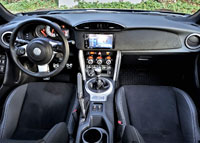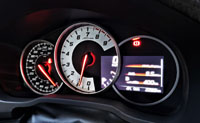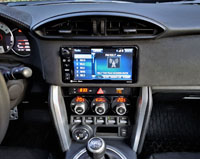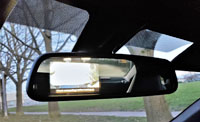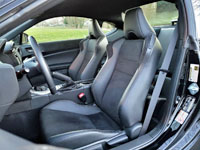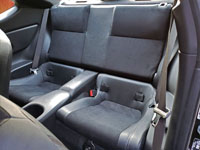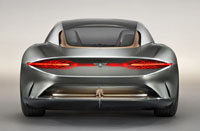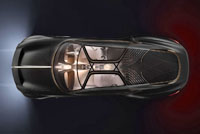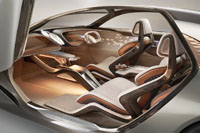
It was only a couple of weeks after Porsche put out a press release announcing Canadian pricing, features and specs for their new 718 Cayman T and 718 Boxster T lightweight performance models, plus details about the base, S, GT4 and Spyder variants of the same updated 2020 Cayman and Boxster, and surprisingly the upcoming 2021 718 GTS was (and still is) all over the interweb.
Up until the current 2020 model year, fourth-generation Cayman and Boxster models were only available with turbocharged four-cylinder powerplants, but thanks to the new GT4 and Spyder a formidable 4.0-litre six-cylinder engine was added to the mix. Now, hot on the heels of those two top-tier 718 models, Porsche is announcing the refreshed 2021 718 Cayman GTS and 718 Boxster GTS with horizontally opposed six-cylinder power as well.
Those who follow all things Porsche will know that the brand’s GTS trim, while not necessarily the fastest in a given model line, will be one of the sportiest thanks to blacked out exterior trim and unique aero upgrades, powertrain improvements, suspension modifications, and more often than not a curb weight reduction, and the new 2021 718 GTS takes all of the above to new extremes.

The outgoing 718 GTS lineup, which was with us from model years 2018 to 2019, already put out an impressive 365-horsepower and 317 lb-ft of torque, but its power came from a 2.5-litre turbocharged flat-four. Sure it was 500 cubic centimetres larger than the 2.0-litre turbo-four in the 718’s base, S and T trims, while making 65 extra horsepower and 37 more lb-ft of torque, but it still wasn’t anywhere near as capable as the naturally aspirated 4.0-litre H-6 in this new GTS.
Porschephiles will already be well aware of the just-mentioned GT4 and Spyder models, particularly about their shared six-cylinder powerplant that boasts 414 horsepower, and while it’s down some 20 horsepower in this new GTS, it still makes a formidable 394 horsepower and an identical 309 pound-feet of torque.
That’s superb performance from a trim that will soon slot between both 718 T models priced at $74,400 for the coupe and $76,800 for the convertible, and the two new top-line cars that start at $110,500 for the Spyder and $113,800 for the GT4. The new engine, which revs all the way up to 7,800 rpm, makes Porsche’s renowned six-cylinder bark and therefore should appeal to the countless diehard fans of the German brand, while the melodic notes emanating from the engine compartment behind the seats get improved upon by a standard twin-tailpipe sport exhaust system.

While fuel efficiency probably isn’t the first reason someone chooses a premium sports car, the new engine includes cylinder deactivation dubbed adaptive cylinder control, a technology that alternately shuts off one of its two cylinder banks under low loads, while the direct injection system uses piezo injectors plus a variable intake system to enhance efficiency further while also improving performance.
Like the sporty 718 T models that we covered in this publication in early January, the new 718 GTS adds standard performance items like a mechanical limited-slip differential, Porsche Torque Vectoring (PTV), and the Sport Chrono Package with a special Porsche Track Precision App featuring a lap timer.
Porsche’s Sport Chrono Package provides a handy “push-to-pass” style Sport Response button in the middle of the steering wheel-mounted rotating drive mode switch, as well as Launch Control with the optional seven-speed dual-clutch automated PDK gearbox.
When using their base six-speed manual transmission, however, both new 2021 718 GTS models sprint from zero to 100 km/h in just 4.5 seconds, paring 0.1 seconds from the outgoing 718 GTS’s acceleration time, while the two only 0.1 seconds slower to 100 km/h than the ultra-hot 718 GT4 and Spyder.
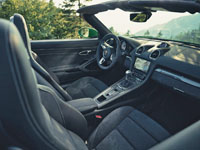
Additionally, the two 718 GTS models increase their top track speeds by 3 km/h to 293 km/h—the GT4 and Spyder manage a respective 304 and 301 km/h. Porsche hasn’t announced performance numbers for the new 718 GTS with its available PDK gearbox, but the dual-clutch paddle-shift actuated transmission slices 0.2 seconds from the GT4 and Spyder’s zero to 100km/h sprint time, so we can expect something similar from the GTS.
Together with the new 718 GTS’ accelerative advantages, a bevy of standard upgrades also make for greater agility around corners, like Porsche Active Drivetrain Mounts (PADM) that integrate dynamic hard and soft transmission mounts to reduce vibration and therefore improve performance, plus the new model’s special Satin-Gloss Black-painted 20-inch alloys encircled by staggered-width 235/35 front and 265/35 rear tires make sure the new 718 models remain glued to the tarmac below.
Porsche’s Active Suspension Management (PASM) electronic damping system also comes standard, the technology instantly adjusting for irregular road surfaces, weather conditions, and changes to driving styles, all depending on whether Normal, Sport, Sport Plus or Individual driving modes are selected.

The two 718 GTS models also get a 20-millimetre drop in suspension height when compared to lesser trims, the 718 T duo aside, lowering their centres of gravity for improved control all-round. The base cast-iron brakes are larger in diameter too, up to 350 mm in front and 33 mm at the rear, resulting in quicker stopping times. Just in case you want to slow down even faster, Porsche provides its usual upgrade to composite ceramic brakes.
In order to visually separate the new GTS models from other 718 trims, Porsche has added dark grey “GTS 4.0” decals to each door, while other styling upgrades include plenty of darkened exterior accents such as a black front lip spoiler, an all-black lower front fascia including a special Sport Design air intake, blackened front fog lamp lenses and taillights, plus a redesigned rear bumper cap and black chrome exhaust tips. Of course, we can’t forget about those glossy black 20-inch alloy wheels mentioned earlier either.
The 718 GTS’s cabin features a GT sport steering wheel, plus a scripted “GTS” logo at the centre of the primary instrument cluster’s rev counter, while woven carbon trim highlights the instrument panel and middle console, and dark grey Alcantara provides plush grip to the steering wheel, the centre console, the gear shift knob and surrounding skirt, each door insert and all of the armrests, plus the centre panels of the standard sport seats, while each A-pillar gets wrapped in the soft suede-like material too, as does the roof liner in the hardtop coupe.

An available GTS interior package lets you choose between contrasting Carmine Red or chalk grey/beige Crayon for the tachometer gauge’s face, the seatbelts, the floor mat borders, and the cabin’s decorative stitching, including embroidered “GTS” logos on each headrest.
The Porsche Communication Management (PCM) centre touchscreen is standard as usual, measuring 7.0 inches and housing plenty of functions pulled up from lower end trims, plus of course the previously noted Track Precision App. This application originated in motorsport, and is downloadable to your Apple or Android smartphone. It provides performance-related data on the GTS’ centre display while on the track, and simultaneously records said data on your device for analysis after leaving the circuit.
The PCM also incorporates a navigation system with real-time traffic information, optional voice control, and Porsche Connect. Additionally, music aficionados will be happy to learn that an available Bose surround sound system can improve on the standard audio system, while Burmester surround sound audio takes the listening experience to an entirely new level.
You’ll be able to order the new 2021 718 Cayman GTS 4.0 and 718 Boxster GTS 4.0 from your Porsche retailer by the summer of 2020, with deliveries following in the fall.
Until that happens, be sure to watch the videos below:
The all new 718 GTS 4.0. More of what you love. (1:52):
Porsche GTS. More of what you love. (1:30):
Story credits: Trevor Hofmann
Photo credits: Porsche




